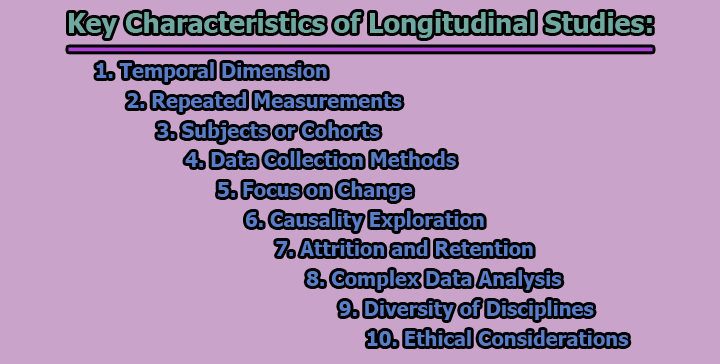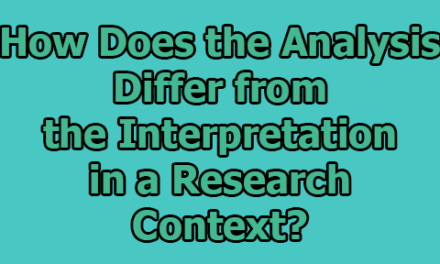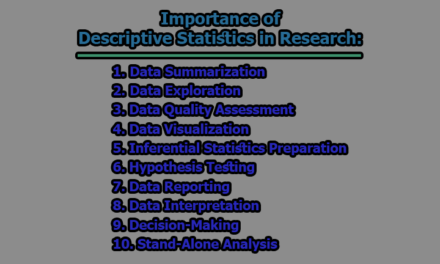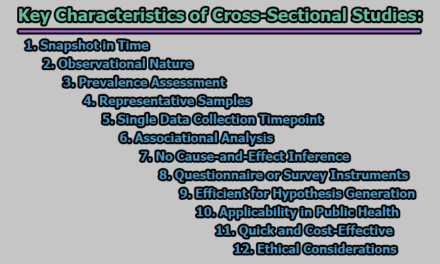A “longitudinal study” is a type of research design that involves the repeated observation or measurement of the same individuals, groups, or subjects over an extended period of time. The goal of a longitudinal study is to track changes, developments, or trends within the study participants over time. This design allows researchers to examine the relationships between variables and observe how they evolve over the course of the study. In the rest of this article, we are going to know about longitudinal study, key characteristics of longitudinal studies, advantages and challenges of longitudinal studies.
Definitions of Longitudinal Study:
A longitudinal study is a rigorous and systematic research design employed in scientific investigations to observe and analyze changes in variables within the same subjects over an extended period. This method allows researchers to track and measure developmental patterns, trends, or causal relationships over time, offering valuable insights into the dynamic nature of phenomena. By collecting data at multiple points in time, scientists can discern patterns of stability, growth, or decline, contributing to a deeper understanding of the underlying processes influencing the subjects under investigation (Scientific Perspective).
From a psychological standpoint, a longitudinal study is a methodological approach that delves into the intricacies of human behavior and development. By following individuals or groups over an extended duration, psychologists aim to unravel the mysteries of how personality traits, cognitive abilities, and emotional states evolve over time. This approach facilitates the exploration of the impact of various life events, experiences, and environmental factors on an individual’s psychological well-being, shedding light on the complexities of the human psyche and providing a nuanced understanding of behavioral changes across the lifespan (Psychological Perspective).
In the realm of sociology, a longitudinal study is an indispensable tool for unraveling the societal tapestry over time. Sociologists employ this method to trace societal shifts, cultural transformations, and the evolution of social structures. By examining the same individuals or communities at different intervals, sociologists can identify patterns of social change, assess the persistence of inequalities, and discern the factors influencing collective behavior. Longitudinal studies in sociology contribute to a comprehensive comprehension of the dynamic interplay between individuals and the larger social milieu (Sociological Perspective).
Within the medical field, a longitudinal study is a critical research approach for investigating health-related phenomena over an extended period. Physicians and researchers utilize this method to monitor the progression of diseases, assess the efficacy of treatments, and identify risk factors that may influence health outcomes. By tracking the health trajectories of individuals or populations, medical professionals can enhance their understanding of disease mechanisms, refine preventive strategies, and contribute valuable insights to the field of public health (Medical Perspective).
In education, a longitudinal study is a valuable research tool employed to explore the academic development and learning trajectories of students over time. Researchers in this field aim to understand the factors influencing educational outcomes, such as academic achievement, dropout rates, and the impact of interventions. Through longitudinal studies, educators gain insights into the effectiveness of instructional methods, educational policies, and the long-term implications of early educational experiences on individuals’ future success in academia and beyond (Educational Perspective).
Key Characteristics of Longitudinal Studies:
Longitudinal studies are a research design characterized by the collection of data from the same subjects over an extended period. These studies offer a unique perspective on the dynamics of change, development, and causality. Here are key characteristics of longitudinal studies:
1. Temporal Dimension (Extended Duration):
Rationale: Longitudinal studies span a prolonged duration, allowing researchers to capture the unfolding dynamics of change and development. The extended timeline is essential for studying processes that take time to manifest, such as cognitive development, the progression of chronic diseases, or the long-term effects of interventions.
Example: A longitudinal study on the impact of early childhood experiences on later life outcomes might follow participants from infancy through adulthood, assessing cognitive, social, and emotional development at various stages.
2. Repeated Measurements (Multiple Data Points):
Rationale: Repeated measurements at different time points provide a comprehensive view of how variables evolve over time. This approach enables the identification of trends, fluctuations, and critical periods of change, enhancing the precision of data analysis and interpretation.
Example: In a study on the effects of a therapeutic intervention on mental health, researchers might collect data through surveys or psychological assessments at regular intervals (e.g., every six months) to observe changes in participants’ well-being over the course of several years.
3. Subjects or Cohorts (Fixed or Open Cohorts):
Rationale: Longitudinal studies organize participants into cohorts based on shared characteristics, such as age, location, or exposure to a particular event. This grouping facilitates the examination of commonalities and differences in developmental trajectories.
Example: A fixed cohort might involve studying individuals born in a specific year, while an open cohort could involve tracking individuals who develop a particular condition over time, regardless of their initial characteristics.
4. Data Collection Methods (Diverse Data Sources):
Rationale: Longitudinal studies employ diverse data collection methods to obtain a comprehensive understanding of the variables under investigation. This may include self-reported data, observations, biological samples, and administrative records, enriching the study’s depth and breadth.
Example: In a longitudinal health study, researchers may combine surveys on lifestyle habits, clinical assessments, and medical records to gain a holistic perspective on the participants’ health status and behaviors over time.
5. Focus on Change (Emphasis on Change Over Time):
Rationale: The central goal of longitudinal studies is to observe and explain changes within individuals, groups, or populations. This emphasis on change over time allows researchers to identify critical periods of development, assess the impact of interventions, and understand the natural trajectories of various phenomena.
Example: A longitudinal study on educational outcomes might focus on how students’ academic performance changes over the course of their schooling, identifying factors that contribute to improvements or setbacks in their learning trajectories.
6. Causality Exploration (Causal Relationships):
Rationale: Longitudinal studies are particularly well-suited for exploring causal relationships between variables. By observing changes over time and accounting for potential confounding factors, researchers can make more informed inferences about causation.
Example: In a study examining the impact of a new teaching method on student achievement, a longitudinal approach allows researchers to assess whether changes in teaching methods precede changes in academic performance, providing insights into potential causal relationships.
7. Attrition and Retention (Challenges of Participant Attrition):
Rationale: Longitudinal studies often face challenges related to participant attrition, where individuals drop out of the study over time. Managing attrition is crucial for maintaining the validity of the study findings and addressing potential biases that may arise if certain groups of participants are more likely to drop out.
Example: A longitudinal health study tracking individuals over several years may encounter attrition due to factors like relocation, loss of interest, or health issues. Researchers must implement strategies to minimize attrition and assess its potential impact on study outcomes.
8. Complex Data Analysis (Sophisticated Statistical Techniques):
Rationale: Analyzing longitudinal data requires advanced statistical techniques that account for the repeated measurements and interdependence of data points. Techniques like growth curve modeling, mixed-effects models, and latent growth curve analysis are commonly used to extract meaningful patterns from complex datasets.
Example: Researchers analyzing longitudinal data on cognitive development may employ growth curve modeling to examine individual trajectories of change in cognitive abilities over time, considering the influence of various factors.
9. Diversity of Disciplines (Interdisciplinary Applications):
Rationale: Longitudinal studies find applications across a wide range of disciplines, including psychology, sociology, medicine, education, and economics. This interdisciplinary approach allows researchers to tackle complex questions that require a holistic understanding of human behavior, development, and societal dynamics.
Example: A collaborative longitudinal study involving psychologists, educators, and sociologists might investigate the long-term effects of early childhood education programs on both academic achievement and social development.
10. Ethical Considerations (Ethical Oversight):
Rationale: Ethical considerations are paramount in longitudinal studies, given the extended duration and potential impact on participants. Researchers must adhere to ethical guidelines, ensuring participant confidentiality, informed consent, and protection from harm throughout the study.
Example: In a study tracking individuals from childhood to adulthood, ethical considerations may include obtaining ongoing consent as participants mature, safeguarding sensitive information, and providing resources for participants who may experience distress during the study.
Advantages of Longitudinal Studies:
- Capture changes and developments over time, providing a comprehensive view of how variables evolve.
- Enable the exploration of cause-and-effect relationships by observing the sequence of events over an extended period.
- Facilitate a detailed understanding of individual trajectories, behaviors, and outcomes.
- Pinpoint critical periods for intervention or the emergence of specific patterns or trends.
- Improve the validity of research findings by minimizing recall bias through real-time data collection.
- Allow for interdisciplinary investigations, incorporating insights from various fields.
- Recognize and account for individual differences in the study population.
- Inform policy decisions by providing evidence on long-term trends and impacts.
- Explore the dynamic interplay between different variables and their influence on outcomes.
- Enable the use of advanced statistical techniques to analyze complex, interrelated data points.
Challenges of Longitudinal Studies:
- High rates of participant dropout over the study duration can compromise the representativeness of the sample.
- Longitudinal studies often require substantial time, funding, and personnel due to their extended nature.
- External factors, such as societal changes or economic shifts, may introduce unforeseen variables that impact the study outcomes.
- Evolving technology or changes in assessment methods over time can introduce measurement inconsistencies.
- Maintaining participant consent and ethical standards over an extended period requires ongoing vigilance.
- Findings may be specific to the studied cohort and may not generalize to other populations or contexts.
- Handling large and complex datasets from multiple time points requires sophisticated data management strategies.
- Maintaining consistent conditions across the study period can be challenging, affecting the internal validity of the research.
- Researchers and participants must commit to the study for an extended duration, which may pose challenges in sustaining engagement.
- Complex statistical analyses are often required, and the risk of spurious correlations increases with multiple comparisons and data points.
In conclusion, the strengths of longitudinal studies lie in their ability to capture the nuances of change, unveil causal connections, and contribute to a deepened understanding of complex phenomena. Despite their merits, these studies are not without challenges, including participant attrition, resource intensiveness, and ethical considerations. However, as researchers navigate these hurdles, the insights gained from longitudinal studies continue to enrich our understanding of human behavior, inform policy decisions, and pave the way for evidence-based interventions, solidifying their significance in the realm of scientific inquiry.
References:
- Babbie, E. R. (2016). The basics of social research. Cengage Learning.
- Cohen, L., & Holliday, M. (2016). Statistics for social scientists. Macmillan International Higher Education.
- Curran, P. J., Obeidat, K., & Losardo, D. (2010). Twelve frequently asked questions about growth curve modeling. Journal of Cognition and Development, 11(2), 121–136. https://doi.org/10.1080/15248371003699969
- Hertzog, C., & Nesselroade, J. R. (2003). Assessing psychological change in adulthood: An overview of methodological issues. Psychology and Aging, 18(4), 639–657. https://doi.org/10.1037/0882-7974.18.4.639
- Johnson, M. K., & Morgan, G. B. (2016). A guide to experimental design. Routledge.
- Little, R. J. A., & Rubin, D. B. (2019). Statistical analysis with missing data (3rd ed.). Wiley.
- Menard, S. (2019). Longitudinal research. Sage Publications.
- Shadish, W. R., Cook, T. D., & Campbell, D. T. (2002). Experimental and quasi-experimental designs for generalized causal inference. Houghton Mifflin.

Assistant Teacher at Zinzira Pir Mohammad Pilot School and College










